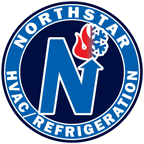Natural Refrigerants: Why the Industry is Shifting to Ammonia and CO₂
Written by Ed Rice
The refrigeration industry is undergoing a major transformation as businesses move away from high-global warming potential (GWP) refrigerants toward natural refrigerants like ammonia (R-717) and carbon dioxide (CO₂, R-744). With stricter environmental regulations, rising energy costs, and increasing sustainability commitments, these natural alternatives are proving to be the future of refrigeration.
While Europe has led the charge in adopting ammonia and CO₂ systems, the United States is now catching up, with new policies such as the American Innovation and Manufacturing (AIM) Act and upcoming HFC phase-downs accelerating the transition.
In this blog, we’ll explore why the industry is shifting, how natural refrigerants are being used worldwide, and what businesses need to know to stay ahead of these changes.
Why the Industry is Moving Away from HFCs
For decades, synthetic refrigerants like R-134a, R-404A, and R-410A have been widely used in commercial and industrial refrigeration. However, due to their high GWP and environmental impact, governments worldwide are phasing them out in favor of low-GWP alternatives.
Regulatory Pressure Driving Change
The Kigali Amendment to the Montreal Protocol – A global agreement that mandates an 85% phase-down of HFCs by 2047 to combat climate change.
The American Innovation and Manufacturing (AIM) Act – A U.S. initiative requiring an HFC reduction of 40% by 2024, with steeper cuts in the following years.
State-Level HFC Regulations – States like California, Massachusetts, and New York are enforcing stricter refrigerant limits ahead of federal mandates.
Rising HFC Costs – As production declines, HFC refrigerant prices are soaring, making natural refrigerants a cost-effective long-term solution.
These regulations mean that businesses must prepare for the transition by upgrading their refrigeration systems or risk facing supply shortages and increased operating costs.
Why Ammonia (R-717) and CO₂ (R-744) Are the Future
Natural refrigerants have been used for over a century, but recent advancements have made them more viable, energy-efficient, and widely adopted in modern refrigeration systems.
1. Low Global Warming Potential (GWP) and Environmental Benefits
Ammonia (R-717) has a GWP of 0 and does not contribute to global warming.
CO₂ (R-744) has a GWP of 1, making it one of the lowest-impact refrigerants available.
Unlike HFCs like R-404A (GWP ~3,922) and R-134a (GWP ~1,430), ammonia and CO₂ help businesses meet sustainability goals while ensuring long-term compliance.
2. Higher Energy Efficiency
Ammonia has excellent heat transfer properties, allowing refrigeration systems to operate with less energy consumption.
CO₂ systems, particularly in low-temperature applications, offer high operational efficiency and can significantly reduce power consumption in industrial settings.
Businesses that switch to high-efficiency ammonia and CO₂ systems often see lower energy bills and reduced maintenance costs over time.
3. Compliance with Current and Future Regulations
Since ammonia and CO₂ are natural refrigerants with ultra-low GWP, they already meet and exceed global environmental regulations. Transitioning to these refrigerants ensures long-term compliance and avoids costly future refrigerant conversions.
4. Cost-Effective and Sustainable Refrigerant Choice
While the initial investment in natural refrigerant systems may be higher, the long-term savings in energy, maintenance, and regulatory compliance make them a more cost-effective solution than synthetic refrigerants.
Natural Refrigerants: The Global Perspective
Europe Leads the Way
Europe has been ahead of the U.S. in transitioning to natural refrigerants, driven by:
Early phase-out of HFCs under the EU F-Gas Regulation.
Strict carbon emissions targets that encourage CO₂ and ammonia adoption.
Financial incentives supporting businesses in upgrading refrigeration systems.
The U.S. is Gaining Momentum
With the AIM Act and rising state-level regulations, the U.S. is now accelerating its transition toward low-GWP refrigeration systems.
Many supermarkets, cold storage facilities, and food processing plants are already investing in CO₂ transcritical systems and ammonia-based refrigeration.
Businesses that make the switch now will stay ahead of regulations and benefit from lower operating costs.
Natural Refrigerants Used Globally
Refrigerant, Common Applications, Primary Regions Using It
Ammonia (R-717), Industrial refrigeration, cold storage, food processing, ice rinks, Europe, U.S., Asia
CO₂ (R-744), Supermarkets, data centers, transportation refrigeration, Europe, U.S., Japan, Australia
Propane (R-290), Small commercial refrigeration, self-contained units, Europe, Australia, parts of U.S.
Isobutane (R-600a), Domestic refrigerators, beverage coolers, Europe, Asia, growing in U.S.
How Businesses Can Transition to Natural Refrigerants
Step 1: Conduct a Refrigerant Audit
Identify refrigerants currently used in your systems.
Evaluate the age and efficiency of existing equipment.
Step 2: Upgrade or Retrofit Systems
Determine whether a retrofit or full system replacement is necessary.
Consider hybrid solutions like CO₂/ammonia cascade systems for maximum efficiency.
Step 3: Ensure Compliance with Regulations
Work with HVAC and refrigeration experts to navigate EPA, OSHA, and ASHRAE standards.
Stay ahead of state and federal refrigerant phase-outs.
Step 4: Take Advantage of Incentives
Apply for federal tax credits and rebates (such as the Inflation Reduction Act).
Check for state-level energy efficiency incentives.
Step 5: Work with an Experienced Refrigeration Partner
Transitioning to natural refrigerants requires specialized expertise. Partnering with a trusted refrigeration company ensures a smooth transition and system optimization.
How Northstar Refrigeration Can Help
At Northstar Refrigeration, we specialize in:
Ammonia and CO₂ refrigeration system design, installation, and maintenance.
Refrigerant transition planning to ensure compliance.
Energy efficiency upgrades for cost savings.
Custom refrigeration solutions tailored to your facility.
Ready to explore natural refrigerant options? Contact Northstar Refrigeration at (508) 888-3692 to learn more!
Final Thoughts
The U.S. is following Europe's lead in adopting natural refrigerants, and businesses that transition early will benefit the most. Switching to CO₂ and ammonia-based refrigeration can reduce operating costs, improve energy efficiency, and meet long-term sustainability goals—all while ensuring compliance with upcoming refrigerant phase-outs.
Don’t wait until regulations force you to change—start planning your transition today!
(508) 888-3692
www.northstarhvacr.com


